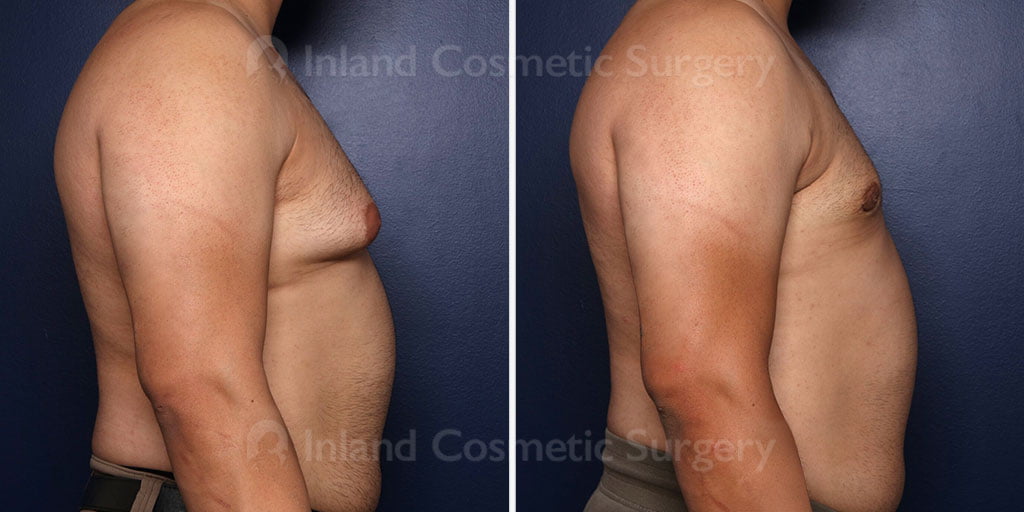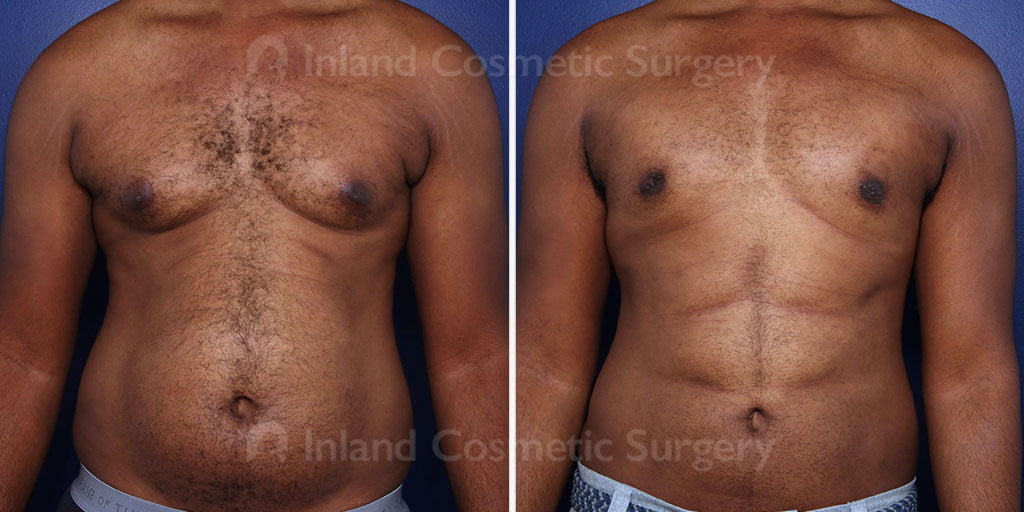Male Breast Reduction (Gynecomastia Surgery)
Something as simple as taking off your t-shirt at the beach shouldn’t make you feel self-conscious. We’d love to help you feel more comfortable by restoring your masculine chest contour.
If you’re feeling uncomfortable about the way you look, it can make feeling confident, happy, and comfortable a tall order. This is particularly true for men who suffer from gynecomastia, a condition where excess tissue and fat on the chest gives the appearance of breasts. Often, it’s near impossible to reduce volume in this area through diet and exercise alone, no matter how many hours you spend working out your upper body.
Although its estimated that around 40% of men of varying ages have some level of gynecomastia, knowing you’re not alone isn’t always enough to make you feel better. Which is why we work with many male patients in the Rancho Cucamonga, Victorville, and Eastvale areas to reduce excess breast tissue and restore a masculine look.

What causes gynecomastia?
Gynecomastia can be caused by certain medical conditions, lifestyle habits, and even your genes. Imbalanced hormones, weight fluctuation or obesity, diabetes, and anabolic steroid use are some of the most common culprits. If a medical condition exists, the underlying cause must be treated first prior to any surgical intervention.
Gynecomastia: Causes, Risks, and Treatment Options
In this video, Dr. Jacob Haiavy of Inland Cosmetic Surgery delves into the causes, risks, and various treatment options available for those seeking relief and confidence. When you meet with our experts at Inland Cosmetic Surgery, they will guide you through the medical and hormonal factors contributing to gynecomastia, potential risks associated with the condition, and the latest surgical and non-surgical treatments that can lead to significant improvements in appearance and self-esteem.
Video Transcript
“A good percentage of the patients that come into our office are males who want to improve their looks and physiques. We do a slew of things, and one of the most common procedures we perform is gynecomastia correction. Gynecomastia is when the breast gland on a male is overly enlarged, and there could be various reasons for it. Sometimes it’s hormonal, so we always do a workup to make sure that the hormones are balanced and that a hormonal imbalance isn’t the cause. But believe it or not, chronic use of marijuana, some steroids, and other factors are contributing risk factors for gynecomastia.
I’ve treated many soldiers from Camp Pendleton who have come in with gynecomastia. After treating a number of them, I asked one of them, “Why is it that so many soldiers have this?” He told me that they take steroids because when they’re in battle—in Afghanistan or Iraq—and need to do operations, the steroids help them stay strong and aggressive. When they stop taking steroids, if it’s not managed properly, they develop gynecomastia.
With this surgery, what we usually do is perform liposuction on the fatty part of the gland. Then, we make a small incision under the areola—the nipple area—and remove the tough, fibrous portion of the gland directly. Patients get excellent results. Their chests are flatter, and they can work out and show their muscles without feeling self-conscious about their nipples sticking out or not looking normal in a tight shirt. I think it’s a great procedure. It’s easy, it’s not a tough recovery, and patients do really well with our gynecomastia surgery technique.”
- Key Benefits
- Glossary
- Improved Chest Contour: The surgery reduces the size of the breasts, resulting in a more traditionally masculine chest contour, which can significantly enhance physical appearance and body proportions.
- Enhanced Physical Comfort: Large breasts can be physically uncomfortable and cause issues such as skin irritation or chafing. Reduction surgery alleviates these discomforts.
- Long-lasting Results: In most cases, the results of male breast reduction surgery are long lasting, especially if the individual maintains a stable weight and follows a healthy lifestyle.
- Anesthesia: Medications used to prevent pain during male breast reduction surgery, can be either local or general.
- Areola: The pigmented skin surrounding the nipple, which may be resized or repositioned during male breast reduction.
- Enlarged Breasts: A condition in men where the breasts are larger than normal, often the reason for seeking male breast reduction surgery.
- Excision: A surgical technique where tissue is cut away and removed, used in gynecomastia surgery to remove glandular breast tissue.
- Glandular Tissue: The breast tissue that develops in gynecomastia, targeted for removal in male breast reduction.
- Gynecomastia: The enlargement of breast tissue in men, often treated surgically with male breast reduction.
- Incisions: Surgical cuts made during male breast reduction, strategically placed to minimize visible scarring.
- Liposuction: A procedure to remove excess fat from the body, often part of male breast reduction to address fatty tissue in the breasts.
- Male Breast Reduction: A surgical procedure to decrease the size of male breasts and improve chest contours.
- Mastectomy: In the context of male breast reduction, this refers to the removal of excess breast tissue.
- Pseudogynecomastia: Enlargement of male breasts primarily due to excess fat, typically treatable with liposuction.
- Recovery Time: The healing period post-surgery, varying based on the procedure’s extent in male breast reduction.
- Skin Elasticity: The ability of the skin to return to normal post-stretching, important for surgical outcomes in breast reduction.
- Subcutaneous Fat: The fat layer under the skin, which may be reduced during male breast reduction.
What happens during male breast reduction to correct gynecomastia?
For many patients who have a mild or moderate case of gynecomastia where most of the excess fullness is caused by fat deposits, we can achieve great results with tumescent liposuction. We first inject a dilute solution of local anesthetic into the fat compartment above the pectoralis muscle before using a small liposuction cannula to remove the excess fat and sculpt a masculine contour that highlights the underlying muscles.
For more severe cases of gynecomastia or if the gland is persistent or fibrous, this procedure may be combined with a direct gland excision. A direct gland excision is performed through a small peri-areolar incision that is naturally hidden by the pigment of the areola.

Recovery after male breast reduction
Depending on how much fat and tissue has been removed, many of our patients are able to return to work and most normal activities within just a few days. The biggest obstacle for our male patients is the time needed off from the gym and chest exercises, which can be a few weeks. Dr. Jacob Haiavy and Dr. Emma Ryan will discuss your individual timeline with you after your procedure, but it’s important not to overwork your chest until you’ve been cleared.
Recovery and Scarring After Gynecomastia Surgery: What to Expect
In this video, Dr. Jacob Haiavy describes the critical aspects of recovery and scarring after gynecomastia surgery, providing a comprehensive overview of what to expect during the healing process. Our expert team of surgeons and patient care coordinators at Inland Cosmetic Surgery are here to help you have a smooth recovery, minimize scarring, and achieve the best possible outcomes. From immediate post-operative care to long-term scar management strategies, we cover everything you need to know to navigate the post-surgery period with confidence and ease.
Video Transcript
“Gynecomastia surgery recovery is not that bad. We recommend patients take a week off work and avoid working out, heavy lifting, pushing, or pulling for three weeks. If you have a physical job, we would like you to be off for those first two to three weeks, but the majority of patients are okay after one week. You can expect some swelling and bruising in the chest area. We provide a vest to wear with a foam dressing underneath it initially. For the first three days, you’ll wear the foam dressing, and after three days, we can remove it. After the first week, I tell patients that if they want to wear something other than the vest, they can. A lot of patients will buy a tight Under Armour shirt that provides nice, even compression, and that works well.
We want compression over the chest area full-time—about 22 out of 24 hours—for the first three weeks. After that, patients can wear it part-time, about 12 hours a day, for another three weeks. Within three weeks, you can go back to doing cardio. Within six weeks, you can go back to doing weights, and you’re back to normal. Usually, we take pictures at about three months.
The incisions are really small. There is one incision around the areola for the gland removal, usually no longer than two or three centimeters, and it blends into the border of the areola, so it heals very well. There is also one tiny incision in the armpit for liposuction of the upper part of the chest. That incision is about the size of the tip of my nail and heals very well. The scars are really inconspicuous and look great.”
Areas served:
Medically reviewed by Dr. Jacob Haiavy — Updated on Feb 24, 2025

